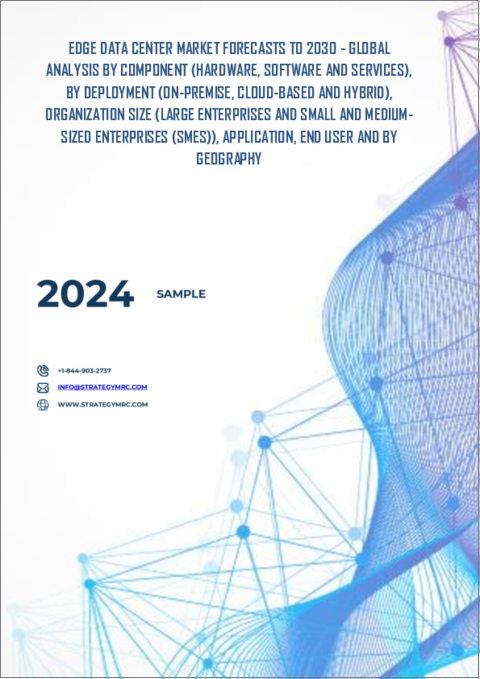|
|
市場調査レポート
商品コード
1438013
エッジデータセンター市場の2030年までの予測:コンポーネント別、展開別、組織規模別、用途別、エンドユーザー別、地域別の世界分析Edge Data Center Market Forecasts to 2030 - Global Analysis By Component, By Deployment, Organization Size (Large Enterprises and Small and Medium-Sized Enterprises ), Application, End User and By Geography |
||||||
カスタマイズ可能
|
|||||||
| エッジデータセンター市場の2030年までの予測:コンポーネント別、展開別、組織規模別、用途別、エンドユーザー別、地域別の世界分析 |
|
出版日: 2024年02月02日
発行: Stratistics Market Research Consulting
ページ情報: 英文 200+ Pages
納期: 2~3営業日
|
全表示
- 概要
- 図表
- 目次
Stratistics MRCによると、世界のエッジデータセンター市場は、2023年に112億米ドルとなり、2030年までには413億米ドルに達すると予測され、予測期間中に20.4%のCAGRで成長する見込みです。
エッジデータセンターは、発生源の近くでデータを処理・保存し、待ち時間を短縮してリアルタイムデータ処理を強化するために設計された、コンパクトで局所的な施設です。エンドユーザーやIoTデバイスの近くに配置されることで、情報への迅速なアクセスが可能になります。エッジデータセンターは、IoT、クラウド・コンピューティング、コンテンツ配信など、低遅延のレスポンスを必要とするアプリケーションをサポートし、必要な場所の近くで効率的なデータ処理を保証します。
USITCによると、2022年現在、世界中に約8,000の物理的データセンターが存在しています。
ビッグデータと人工知能(AI)の台頭
ビッグデータと人工知能の台頭は、エッジデータセンター市場の重要な促進要因です。企業がデータ集約型アプリケーションの活用やAIアルゴリズムの導入を進めるにつれ、リアルタイム処理とレイテンシーの短縮に対する需要が高まっています。エッジデータセンターは、データソースにより近い場所に配置されるため、迅速なデータ分析と意思決定が可能になります。この近接性により、ビッグデータ分析やAIアプリケーションの効率が向上し、先進技術の開発が促進され、エッジコンピューティングソリューションの導入が推進されます。
高い初期費用と複雑な展開
インフラ、ネットワーク、セキュリティ対策など、エッジデータセンターの設立に必要な初期投資は、組織によっては法外な金額になることもあります。さらに、エッジでの分散コンピューティングインフラの展開と管理の複雑さが課題となり、専門的な知識が要求されます。エンドユーザーに近い場所で低レイテンシーかつ高性能なコンピューティングを利用したいというニーズが高まっているにもかかわらず、こうした要因は、特に中小企業にとって、普及の妨げになる可能性があります。
5Gやその他の高度なネットワークの普及
5G技術の採用が進むと、データ転送速度が向上し、待ち時間が短縮されるため、エッジ・コンピューティング・アプリケーションに貢献する環境が整います。エンドユーザーに近い位置にあるエッジデータセンターは、こうした高速ネットワークを活用して、低遅延でリアルタイムのサービスを提供できます。この相乗効果により、エッジコンピューティングと5Gのシームレスな統合が促進され、接続性の強化、パフォーマンスの向上、新興技術のサポートといった新たな可能性が開けます。
熟練した専門家と標準化されたソリューションの不足
熟練した専門家の不足と標準化されたソリューションの不在は、大きな脅威となっています。エッジコンピューティングの急速な成長には、導入と管理に専門的な知識が必要です。熟練した専門家の不足は、エッジデータセンターの効果的な導入を妨げる可能性があります。さらに、標準化されたソリューションがないため、相互運用性に課題が生じ、シームレスな統合が妨げられる可能性があります。
COVID-19の影響:
COVID-19の大流行は、企業や産業がリモートワーク、デジタルサービス、クラウドコンピューティングへの依存度を高める方向にシフトするにつれて、エッジデータセンターの需要を加速させています。低レイテンシーで高性能なコンピューティングをエンドユーザーの近くで利用する必要性が極めて重要になり、エッジ・コンピューティング・ソリューションの採用が推進されました。パンデミックは、弾力性のある分散データインフラの重要性を浮き彫りにし、接続性と拡張性を強化し、IoTや自律システムのような新技術をサポートするためにエッジデータセンターに投資するよう組織に促しました。
予測期間中、ソフトウェア分野が最大になる見込み
ソフトウェア分野は、エッジデータセンターの機能性を高める上で極めて重要な役割を果たすため、予測期間中に最大となる見通しです。企業はデータ主導の意思決定とリアルタイムの分析を優先するため、エッジコンピューティングのデータ処理と分析をサポートするソフトウェアソリューションへの需要が高まっています。エッジコンピューティング環境の複雑化に伴い、ソフトウェア分野は大幅な成長が見込まれており、エッジデータセンター市場の主要な貢献者となっています。
予測期間中にCAGRが最も高くなると予測される中小企業セグメント
中小企業(SMEs)セグメントは、予測期間中に最も高い成長が見込まれます。この成長の背景には、中小企業におけるデジタル化への取り組みの増加、クラウドベースのソリューション採用の増加、スケーラブルでコスト効率に優れたデータ管理のニーズがあります。中小企業は、エッジデータセンターが業務効率を向上させるという利点を認識しており、こうしたソリューションへの投資を拡大し、今後数年間の同セグメントの成長加速に貢献するとみられます。
最大のシェアを占める地域:
北米地域は、先進技術の普及、堅牢なITインフラ、データ集約型アプリケーションの急増により、予測期間中、市場を独占すると予想されます。低遅延処理、エッジコンピューティングアプリケーション、IoTデバイスの急速な成長に対する需要の増加が、この地域のリーダーシップに寄与しています。さらに、主要な市場プレーヤーが存在し、データセンターインフラへの投資が活発であることから、北米はエッジデータセンターの市場シェア拡大に大きく貢献しています。
CAGRが最も高い地域:
アジア太平洋は、市場の大幅な成長が見込まれています。この急成長の背景には、デジタル化の進展、IoTデバイスの急速な普及、低遅延データ処理に対する需要の高まりがあります。同地域のクラウドインフラの拡大、データトラフィックの急増、政府の支援策が、同地域の隆盛に寄与しています。企業が接続性の向上とリアルタイムのデータアクセスを目指す中、アジア太平洋はエッジデータセンターの主要市場として、大きな成長の可能性を示しています。
無料のカスタマイズサービス:
本レポートをご購読のお客様には、以下の無料カスタマイズオプションのいずれかをご利用いただけます:
- 企業プロファイル
- 追加市場プレイヤーの包括的プロファイリング(3社まで)
- 主要企業のSWOT分析(3社まで)
- 地域セグメンテーション
- 顧客の関心に応じた主要国の市場推計・予測・CAGR(注:フィージビリティチェックによる)
- 競合ベンチマーキング
- 製品ポートフォリオ、地理的プレゼンス、戦略的提携に基づく主要企業のベンチマーキング
目次
第1章 エグゼクティブサマリー
第2章 序文
- 概要
- ステークホルダー
- 調査範囲
- 調査手法
- データマイニング
- データ分析
- データ検証
- 調査アプローチ
- 調査ソース
- 1次調査ソース
- 2次調査ソース
- 前提条件
第3章 市場動向分析
- 促進要因
- 抑制要因
- 機会
- 脅威
- アプリケーション分析
- エンドユーザー分析
- COVID-19の影響
第4章 ポーターのファイブフォース分析
- 供給企業の交渉力
- 買い手の交渉力
- 代替品の脅威
- 新規参入業者の脅威
- 競争企業間の敵対関係
第5章 世界のエッジデータセンター市場:コンポーネント別
- ハードウェア
- サーバー
- ストレージデバイス
- ネットワーク機器
- ソフトウェア
- 管理
- 分析
- オーケストレーション
- サービス
- デザイン
- 導入
- メンテナンス
第6章 世界のエッジデータセンター市場:展開別
- オンプレミス
- クラウドベース
- ハイブリッド
第7章 世界のエッジデータセンター市場:組織規模別
- 大企業
- 中小企業(SME)
第8章 世界のエッジデータセンター市場:アプリケーション別
- 自動運転車
- コンテンツ配信ネットワーク(CDN)
- 産業自動化
- モノのインターネット(IoT)
- スマートシティ
- その他の用途
第9章 世界のエッジデータセンター市場:エンドユーザー別
- エネルギー
- ヘルスケア
- IT・テレコム
- 小売り
- その他のエンドユーザー
第10章 世界のエッジデータセンター市場:地域別
- 北米
- 米国
- カナダ
- メキシコ
- 欧州
- ドイツ
- 英国
- イタリア
- フランス
- スペイン
- その他欧州
- アジア太平洋
- 日本
- 中国
- インド
- オーストラリア
- ニュージーランド
- 韓国
- その他アジア太平洋
- 南米
- アルゼンチン
- ブラジル
- チリ
- その他南米
- 中東・アフリカ
- サウジアラビア
- アラブ首長国連邦
- カタール
- 南アフリカ
- その他中東・アフリカ
第11章 主な発展
- 契約、パートナーシップ、コラボレーション、合弁事業
- 買収と合併
- 新製品の発売
- 事業拡大
- その他の主要戦略
第12章 企業プロファイル
- Akamai Technologies
- AT&T
- Compass Datacenters
- CoreSite
- CyrusOne
- Dell
- EdgeConneX
- EdgePresence
- Equinix
- Flexential
- Hivelocity
- Nokia
- Nvidia
- Siemon
- Stack Infrastructure
- Telefonaktiebolaget LM Ericsson
- Vapor IO
- Verizon
- Zenlayer
List of Tables
- Table 1 Global Edge Data Center Market Outlook, By Region (2021-2030) ($MN)
- Table 2 Global Edge Data Center Market Outlook, By Component (2021-2030) ($MN)
- Table 3 Global Edge Data Center Market Outlook, By Hardware (2021-2030) ($MN)
- Table 4 Global Edge Data Center Market Outlook, By Servers (2021-2030) ($MN)
- Table 5 Global Edge Data Center Market Outlook, By Storage Devices (2021-2030) ($MN)
- Table 6 Global Edge Data Center Market Outlook, By Network Equipment (2021-2030) ($MN)
- Table 7 Global Edge Data Center Market Outlook, By Software (2021-2030) ($MN)
- Table 8 Global Edge Data Center Market Outlook, By Management (2021-2030) ($MN)
- Table 9 Global Edge Data Center Market Outlook, By Analytics (2021-2030) ($MN)
- Table 10 Global Edge Data Center Market Outlook, By Orchestration (2021-2030) ($MN)
- Table 11 Global Edge Data Center Market Outlook, By Services (2021-2030) ($MN)
- Table 12 Global Edge Data Center Market Outlook, By Design (2021-2030) ($MN)
- Table 13 Global Edge Data Center Market Outlook, By Deployment (2021-2030) ($MN)
- Table 14 Global Edge Data Center Market Outlook, By Maintenance (2021-2030) ($MN)
- Table 15 Global Edge Data Center Market Outlook, By Deployment (2021-2030) ($MN)
- Table 16 Global Edge Data Center Market Outlook, By On-premise (2021-2030) ($MN)
- Table 17 Global Edge Data Center Market Outlook, By Cloud-based (2021-2030) ($MN)
- Table 18 Global Edge Data Center Market Outlook, By Hybrid (2021-2030) ($MN)
- Table 19 Global Edge Data Center Market Outlook, By Organization Size (2021-2030) ($MN)
- Table 20 Global Edge Data Center Market Outlook, By Large Enterprises (2021-2030) ($MN)
- Table 21 Global Edge Data Center Market Outlook, By Small and Medium-Sized Enterprises (SMEs) (2021-2030) ($MN)
- Table 22 Global Edge Data Center Market Outlook, By Application (2021-2030) ($MN)
- Table 23 Global Edge Data Center Market Outlook, By Autonomous Vehicles (2021-2030) ($MN)
- Table 24 Global Edge Data Center Market Outlook, By Content Delivery Networks (CDNs) (2021-2030) ($MN)
- Table 25 Global Edge Data Center Market Outlook, By Industrial Automation (2021-2030) ($MN)
- Table 26 Global Edge Data Center Market Outlook, By Internet of Things (IoT) (2021-2030) ($MN)
- Table 27 Global Edge Data Center Market Outlook, By Smart Cities (2021-2030) ($MN)
- Table 28 Global Edge Data Center Market Outlook, By Other Applications (2021-2030) ($MN)
- Table 29 Global Edge Data Center Market Outlook, By End User (2021-2030) ($MN)
- Table 30 Global Edge Data Center Market Outlook, By Energy (2021-2030) ($MN)
- Table 31 Global Edge Data Center Market Outlook, By Healthcare (2021-2030) ($MN)
- Table 32 Global Edge Data Center Market Outlook, By IT and Telecom (2021-2030) ($MN)
- Table 33 Global Edge Data Center Market Outlook, By Retail (2021-2030) ($MN)
- Table 34 Global Edge Data Center Market Outlook, By Other End Users (2021-2030) ($MN)
Note: Tables for North America, Europe, APAC, South America, and Middle East & Africa Regions are also represented in the same manner as above.
According to Stratistics MRC, the Global Edge Data Center Market is accounted for $11.2 billion in 2023 and is expected to reach $41.3 billion by 2030 growing at a CAGR of 20.4% during the forecast period. Edge Data Center is a compact and localized facility designed for processing and storing data near the source of generation, reducing latency and enhancing real-time data processing. Positioned closer to end-users or IoT devices, it facilitates faster access to information. Edge Data Centers support applications requiring low-latency responses, such as IoT, cloud computing and content delivery, ensuring efficient data handling in proximity to where it is needed.
According to USITC, as of 2022, there are approximately 8000 physical data centres present across the globe.
Market Dynamics:
Driver:
Rise of big data and artificial intelligence (AI)
The rise of big data and artificial intelligence is a significant driver in the edge data center market. As organizations increasingly leverage data-intensive applications and deploy AI algorithms, there's a growing demand for real-time processing and reduced latency. Edge data centers, positioned closer to the data source, enable quick data analysis and decision-making. This proximity enhances the efficiency of big data analytics and AI applications, fostering the development of advanced technologies and driving the adoption of edge computing solutions.
Restraint:
High upfront costs and complex deployment
The initial investment required for establishing edge data centers, including infrastructure, networking and security measures, can be prohibitive for some organizations. Additionally, the intricacies of deploying and managing distributed computing infrastructure at the edge pose challenges, demanding specialized expertise. These factors may hinder widespread adoption, especially for smaller enterprises, despite the growing demand for low-latency, high-performance computing closer to end-users.
Opportunity:
Proliferation of 5G and other advanced networks
Increasing adoption of 5G technology enhances data transfer speeds and reduces latency, creating a contributing environment for edge computing applications. Edge Data Centers, positioned closer to end-users, can leverage these high-speed networks to deliver low-latency and real-time services. This synergy facilitates the seamless integration of edge computing with 5G, unlocking new possibilities for enhanced connectivity, improved performance and support for emerging technologies.
Threat:
Lack of skilled professionals and standardized solutions
The shortage of skilled professionals and the absence of standardized solutions pose significant threats. The rapid growth of edge computing demands specialized expertise for deployment and management. The shortage of skilled professionals can hinder the effective implementation of edge data centers. Additionally, the lack of standardized solutions may lead to interoperability challenges and hinder seamless integration.
Covid-19 Impact:
The COVID-19 pandemic has accelerated the demand for edge data centers as businesses and industries shift towards remote work, digital services and increased reliance on cloud computing. The need for low-latency and high-performance computing closer to end-users became crucial, driving the adoption of edge computing solutions. The pandemic underscored the importance of resilient and distributed data infrastructure, prompting organizations to invest in edge data centers to enhance connectivity and scalability and support emerging technologies like IoT and autonomous systems.
The software segment is expected to be the largest during the forecast period
The software segment is poised to be the largest during the forecast period due to its pivotal role in advancing edge data center functionalities. Businesses prioritize data-driven decision-making and real-time analytics, the demand for software solutions supporting edge computing data processing and analytics is escalating. With the growing complexity of edge computing environments, the software segment is expected to witness substantial growth, making it a key contributor to the edge data center market.
The small and medium-sized enterprises (SMEs) segment is expected to have the highest CAGR during the forecast period
The small and medium-sized enterprises (SMEs) segment is anticipated to experience the highest growth over the forecast period. This growth is driven by increasing digitalization efforts among SMEs, rising adoption of cloud-based solutions and the need for scalable and cost-effective data management. SMEs, recognizing the advantages of edge data centers in enhancing operational efficiency, are likely to invest more in these solutions, contributing to the segment's accelerated growth in the coming years.
Region with largest share:
The North American region is expected to dominate the market during the forecast period due to widespread adoption of advanced technologies, robust IT infrastructure and a surge in data-intensive applications. Increasing demand for low-latency processing, edge computing applications and the rapid growth of IoT devices contribute to the region's leadership. Additionally, the presence of key market players, coupled with substantial investments in data center infrastructure, positions North America as a significant contributor to the expanding market share of edge data centers.
Region with highest CAGR:
The Asia-Pacific region is poised for substantial growth in the market. This surge is fueled by increasing digitization, the rapid adoption of IoT devices and escalating demand for low-latency data processing. The region's expanding cloud infrastructure, burgeoning data traffic and supportive government initiatives contribute to its prominence. As businesses strive for improved connectivity and real-time data access, the Asia Pacific stands as a key market for edge data centers, showcasing significant growth potential.
Key players in the market
Some of the key players in Edge Data Center Market include Akamai Technologies, AT&T, Compass Datacenters, CoreSite, CyrusOne, Dell, EdgeConneX, EdgePresence, Equinix, Flexential, Hivelocity, Nokia, Nvidia, Siemon , Stack Infrastructure, Telefonaktiebolaget LM Ericsson, Vapor IO, Verizon and Zenlayer.
Key Developments:
In July 2023, Siemon launched new EagleEye Red software for managing data center and LAN networks. Its multi-tiered network discovery protocols allow users to quickly scan and find all IP-based devices within their network and position assets at their correct locations.
In June 2023, Dell has recently expanded its Dell Private Wireless Program, aiming to offer secure enterprise connectivity for edge locations. The program now supports Airspan and Druid wireless solutions, providing businesses with enhanced options for reliable wireless connectivity at the edge.
In May 2023, NVIDIA launched a new class of large-memory AI supercomputer, the NVIDIA DGX. The NVIDIA GH200 Grace Hopper Superchips and the NVIDIA NVLink Switch System drive this powerful system. It facilitates the development of massive, next-generation models for generative AI language applications, recommender systems, and data analytics workloads.
Components Covered:
- Hardware
- Software
- Services
Deployments Covered:
- On-premise
- Cloud-based
- Hybrid
Organization Sizes Covered:
- Large Enterprises
- Small and Medium-Sized Enterprises (SMEs)
Applications Covered:
- Autonomous Vehicles
- Content Delivery Networks (CDNs)
- Industrial Automation
- Internet of Things (IoT)
- Smart Cities
- Other Applications
End Users Covered:
- Energy
- Healthcare
- IT and Telecom
- Retail
- Other End Users
Regions Covered:
- North America
- US
- Canada
- Mexico
- Europe
- Germany
- UK
- Italy
- France
- Spain
- Rest of Europe
- Asia Pacific
- Japan
- China
- India
- Australia
- New Zealand
- South Korea
- Rest of Asia Pacific
- South America
- Argentina
- Brazil
- Chile
- Rest of South America
- Middle East & Africa
- Saudi Arabia
- UAE
- Qatar
- South Africa
- Rest of Middle East & Africa
What our report offers:
- Market share assessments for the regional and country-level segments
- Strategic recommendations for the new entrants
- Covers Market data for the years 2021, 2022, 2023, 2026, and 2030
- Market Trends (Drivers, Constraints, Opportunities, Threats, Challenges, Investment Opportunities, and recommendations)
- Strategic recommendations in key business segments based on the market estimations
- Competitive landscaping mapping the key common trends
- Company profiling with detailed strategies, financials, and recent developments
- Supply chain trends mapping the latest technological advancements
Free Customization Offerings:
All the customers of this report will be entitled to receive one of the following free customization options:
- Company Profiling
- Comprehensive profiling of additional market players (up to 3)
- SWOT Analysis of key players (up to 3)
- Regional Segmentation
- Market estimations, Forecasts and CAGR of any prominent country as per the client's interest (Note: Depends on feasibility check)
- Competitive Benchmarking
- Benchmarking of key players based on product portfolio, geographical presence, and strategic alliances
Table of Contents
1 Executive Summary
2 Preface
- 2.1 Abstract
- 2.2 Stake Holders
- 2.3 Research Scope
- 2.4 Research Methodology
- 2.4.1 Data Mining
- 2.4.2 Data Analysis
- 2.4.3 Data Validation
- 2.4.4 Research Approach
- 2.5 Research Sources
- 2.5.1 Primary Research Sources
- 2.5.2 Secondary Research Sources
- 2.5.3 Assumptions
3 Market Trend Analysis
- 3.1 Introduction
- 3.2 Drivers
- 3.3 Restraints
- 3.4 Opportunities
- 3.5 Threats
- 3.6 Application Analysis
- 3.7 End User Analysis
- 3.8 Impact of Covid-19
4 Porters Five Force Analysis
- 4.1 Bargaining power of suppliers
- 4.2 Bargaining power of buyers
- 4.3 Threat of substitutes
- 4.4 Threat of new entrants
- 4.5 Competitive rivalry
5 Global Edge Data Center Market, By Component
- 5.1 Introduction
- 5.2 Hardware
- 5.2.1 Servers
- 5.2.2 Storage Devices
- 5.2.3 Network Equipment
- 5.3 Software
- 5.3.1 Management
- 5.3.2 Analytics
- 5.3.3 Orchestration
- 5.4 Services
- 5.4.1 Design
- 5.4.2 Deployment
- 5.4.3 Maintenance
6 Global Edge Data Center Market, By Deployment
- 6.1 Introduction
- 6.2 On-premise
- 6.3 Cloud-based
- 6.4 Hybrid
7 Global Edge Data Center Market, By Organization Size
- 7.1 Introduction
- 7.2 Large Enterprises
- 7.3 Small and Medium-Sized Enterprises (SMEs)
8 Global Edge Data Center Market, By Application
- 8.1 Introduction
- 8.2 Autonomous Vehicles
- 8.3 Content Delivery Networks (CDNs)
- 8.4 Industrial Automation
- 8.5 Internet of Things (IoT)
- 8.6 Smart Cities
- 8.7 Other Applications
9 Global Edge Data Center Market, By End User
- 9.1 Introduction
- 9.2 Energy
- 9.3 Healthcare
- 9.4 IT and Telecom
- 9.5 Retail
- 9.6 Other End Users
10 Global Edge Data Center Market, By Geography
- 10.1 Introduction
- 10.2 North America
- 10.2.1 US
- 10.2.2 Canada
- 10.2.3 Mexico
- 10.3 Europe
- 10.3.1 Germany
- 10.3.2 UK
- 10.3.3 Italy
- 10.3.4 France
- 10.3.5 Spain
- 10.3.6 Rest of Europe
- 10.4 Asia Pacific
- 10.4.1 Japan
- 10.4.2 China
- 10.4.3 India
- 10.4.4 Australia
- 10.4.5 New Zealand
- 10.4.6 South Korea
- 10.4.7 Rest of Asia Pacific
- 10.5 South America
- 10.5.1 Argentina
- 10.5.2 Brazil
- 10.5.3 Chile
- 10.5.4 Rest of South America
- 10.6 Middle East & Africa
- 10.6.1 Saudi Arabia
- 10.6.2 UAE
- 10.6.3 Qatar
- 10.6.4 South Africa
- 10.6.5 Rest of Middle East & Africa
11 Key Developments
- 11.1 Agreements, Partnerships, Collaborations and Joint Ventures
- 11.2 Acquisitions & Mergers
- 11.3 New Product Launch
- 11.4 Expansions
- 11.5 Other Key Strategies
12 Company Profiling
- 12.1 Akamai Technologies
- 12.2 AT&T
- 12.3 Compass Datacenters
- 12.4 CoreSite
- 12.5 CyrusOne
- 12.6 Dell
- 12.7 EdgeConneX
- 12.8 EdgePresence
- 12.9 Equinix
- 12.10 Flexential
- 12.11 Hivelocity
- 12.12 Nokia
- 12.13 Nvidia
- 12.14 Siemon
- 12.15 Stack Infrastructure
- 12.16 Telefonaktiebolaget LM Ericsson
- 12.17 Vapor IO
- 12.18 Verizon
- 12.19 Zenlayer





